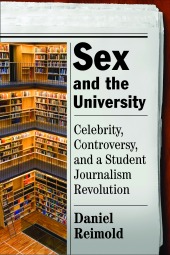In 2007, when Madison McCord enrolled at Spokane Falls Community College in Washington, The Communicator student newspaper sported a two-year-old clunker of a website. As McCord, the newspaper’s web editor, recalled, “It was very basic with an outdated color palette and a lot of text.”
—
Although no Communicator staffers had any new media or graphics experience, McCord knew they had to embark on an online revamp worthy of Journalism 2.0. He spent Spring Break 2009 with one fellow editor enmeshed in Dreamweaver and Flash for Dummies books. “We then designed our graphics and built our site from the ground up,” he said. “We used no pre-built templates or code.”
—
Two weeks later, the Communicator‘s site was named an Associated Collegiate Press Online Pacemaker award finalist in the two-year schools category. In fall 2009, it emerged as the winner. In 2010, it was nominated again (now in a more general small schools category).
—

Madison McCord is the web editor of The Communicator Online at Spokane Falls Community College
—
In honor of his self-taught web prowess and his oversight of a top-notch, hand-coded (!) news site, McCord rightfully earns a spot in the CMM Student Journalist Spotlight. Below, he speaks about his online journalism work and offers advice for students aspiring to follow in his stead.
—
What were your goals for the revamped site?
—
When the site launched, we felt it was necessary to write the following mission statement:
—
The Communicator Online, the affiliate news site of The Communicator, takes the concept of how students at Spokane Falls Community College get their news and transforms its presentation from the traditional to the cutting edge of collegiate journalism. With The Communicator Online, it is our job to know how and when students want to access their news. We stress the use of social media tools such as Facebook and Twitter to bring our campus news to students, ranging from campus reports to features with their friends and family. We try to offer online alternatives that our print edition can’t offer. Our new and fresh multimedia presentations and re-occurring Podcasts allow students to access news comparable to professional outlets, but not from those run by students.
—
With exclusive web and breaking news stories, we allow our readers to examine every angle of a story, as well as the ability to retrieve information however they may choose. This was the driving decision to create a hand-coded site and maintain said site in-house instead of using a pre-built content management system or hiring professionals to design and maintain the site.
—
We have created a separate J-Courses page for both students enrolled in a course and those outside of the program who show an interest in Journalism. They can access PowerPoint presentations, important course documents, online tutorials and journalism-related links that help them reach their journalistic goals. This tool takes The Communicator Online from the level of a new-media focused news site, to one of the most useful services for students on our campus and in our community.
—

—
What were the biggest challenges as you went through the revamp process?
—
We had to create a successful, navigable website that differed from our print edition. To accomplish this we have entered the “new media” realm, with the production of an iPad/iPhone web app. It’s no surprise that our market is consistently changing, and as students, we have been presented an opportunity to figure out the industry in a consequence-free environment. Since we built the site, we have implemented tools like Twitter, Facebook, Flash presentation and an interest in multimedia production. These tools and the addition of new tools are our biggest challenge as far as keeping pace with the industry.
—
—
What led to your decision to hand-code?
—
Our decision to hand-code was very easy. We wanted the site our way. By hand-coding, we were able to adjust every part of our site and customize it to what our consumer wants. The one thing that students underestimate is the fact that hand-coding is easy to learn. We were also pushed by our adviser Jason Nix to go hand-code as opposed to using a template-based site. We feel that the lessons and experience we get from hand-coding will benefit us in the long run.
—
—
What part of the site are you most proud to have put in place?
—
This is a three-way tie. On one hand, we have worked very hard to give our viewers the complete multimedia experience in every possible story. Only text and photos exist in print. We have the capability to present audio, video, galleries and other products with a website, and we want to utilize all of those tools.
—
Second is our J-Courses page. Students are our main focus, and our college offers five journalism courses. With this page, the instructors are able to post PowerPoints, lecture notes, screencasts, links and assignments. This page also opens up our curriculum to any student who wants to learn about journalism. Lastly, I’m proud of our iPad/iPhone web app. This technology is the future of media, and we as a student paper want to make sure we are getting the most of these new tools and technologies.
—
—
Any advice for editors at other student media outlets looking to up their own web games?
—
The one thing that I see more than anything else on college news sites is the lack of professional multimedia or multimedia content all together. A good multimedia presence can take a site that is lackluster to one that students will appreciate and visit repeatedly. Also, other sites cannot be afraid of change and learning new tools. Yes, programs like Flash take time and effort to learn, but the product that comes out of this increased effort will enhance any organization’s web presence.
Read Full Post »






















